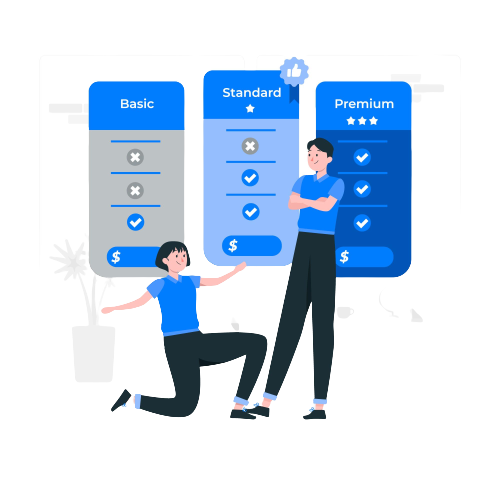
Subscription-based services have a long and fascinating history that dates back centuries. The concept of subscriptions can be traced to ancient times when people would subscribe to receive regular deliveries of goods or services. One of the earliest recorded instances of subscription-based services can be found in ancient Rome, where wealthy citizens would subscribe to receive exclusive access to public baths or entertainment events.
During the 17th and 18th centuries, the subscription model gained popularity in the publishing industry. Books, newspapers, and magazines started offering subscriptions to their readers, allowing them to receive regular editions of publications. This model proved to be a win-win situation for both publishers and subscribers. Publishers could ensure a steady income and estimate print runs accurately, while subscribers enjoyed the convenience of receiving fresh content without the need to make repeated purchases.
One of the most notable early examples of subscription management services can be seen in the publishing industry during the 19th century. Newspapers and magazines became a crucial part of people’s lives, and subscriptions played a significant role in their distribution and business model. Readers would subscribe to their favorite newspapers to stay informed about local and international news, politics, and social events.
The concept of subscription management service was not limited to publishing. Traditional industries, such as utilities and telecommunications, also embraced subscription-based models. In the early 20th century, many households subscribed to utility services like electricity, water, and gas. These subscriptions allowed for consistent billing cycles and helped providers manage their resources efficiently.
Similarly, subscription-based services were integral to the development of cable television. Subscribers could access a broad range of channels for a regular fee, marking a shift from traditional free-to-air broadcasting.
In general, subscription management service in traditional industries demonstrated the effectiveness of creating ongoing relationships with customers. By providing valuable and consistent services, businesses were able to cultivate loyalty and retain customers over time.
The historical roots of subscription models reveal a deep-seated human desire for convenience and continuous access to valuable services. From ancient Rome to modern-day subscription-based businesses, the model has proven its adaptability and effectiveness.
As technology continues to evolve, subscription management service has become more sophisticated, enabling businesses to tailor offerings, improve customer experiences, and drive customer retention. The subscription-based approach has not only revolutionized how businesses operate but has also transformed how consumers engage with products and services, making it a crucial part of today’s dynamic business landscape.
Modern Trends In subscription management service
In recent years, there has been a remarkable surge in the popularity of subscription-based businesses across various industries. From entertainment and media to e-commerce and software, subscriptions have become the go-to model for companies seeking recurring revenue and long-term customer loyalty. This rise can be attributed to several key factors that have contributed to the widespread adoption of subscription services.
- Changing Consumer Preferences: Consumer preferences have shifted from ownership to access. In the past, individuals preferred owning physical products, but with the digital revolution, the focus has moved towards convenient access to services and content. This shift has created a fertile ground for subscription-based models, offering customers access to a wide range of products and services without the need for ownership.
- Convenience and Personalization: Subscriptions offer convenience and personalization, providing customers with tailored experiences based on their preferences and needs. Companies can leverage data analytics to understand customer behavior and deliver personalized recommendations, enhancing the overall customer experience.
- Cost-Effectiveness: For consumers, subscriptions often present a cost-effective solution. Instead of purchasing individual products or services, subscribing to a bundled offering can result in significant savings. For businesses, subscription models can provide a more predictable and stable revenue stream, making financial planning and forecasting more manageable.
- Evolving Technology: Advancements in technology, particularly the internet and mobile devices, have played a crucial role in facilitating the growth of subscription services. With easy access to online platforms and seamless payment gateways, subscribing to services has never been easier for consumers, driving the adoption of subscription models.
- Diversification of Offerings: Subscription-based businesses have diversified their offerings beyond traditional sectors. Today, you can find subscriptions for streaming services, meal kits, beauty products, fitness classes, and even pet care. The ability to cater to niche markets and cater to specialized interests has expanded the subscription economy’s reach.
Subscription Economy: Understanding the Concept and Impact

The subscription economy refers to a broader economic shift where businesses focus on building long-term relationships with customers through subscription-based models. This shift has had a profound impact on both consumer behavior and business strategies.
- Customer-Centric Approach: The subscription economy places the customer at the center of the business model. Instead of focusing on one-time transactions, companies are incentivized to prioritize customer satisfaction and retention. This emphasis on customer experience and loyalty has led to better customer service and continuous improvement of products and services.
- Recurring Revenue and Predictability: For businesses, recurring revenue from subscriptions offers stability and predictability. This steady cash flow allows companies to plan for the future, invest in innovation, and expand their offerings. As a result, startups and established businesses alike are adopting subscription models to secure a more sustainable future.
- Shift from Products to Services: The subscription economy has spurred a shift from traditional product-centric models to service-oriented approaches. Instead of selling products, companies are increasingly offering their products as part of ongoing services, adding value and convenience for customers.
- Customer Lifetime Value (CLV): With subscription models, businesses focus on maximizing the customer lifetime value (CLV). By keeping customers engaged and subscribed for longer periods, companies can boost revenue and profitability. This emphasis on CLV aligns with the principle of customer retention being more cost-effective than customer acquisition.
- Disruption and Market Competition: The subscription economy has disrupted traditional business models and market dynamics. Established companies have faced competition from startups offering innovative subscription services. As a result, businesses are compelled to stay agile, constantly innovate, and adapt to changing customer needs to stay ahead in the market.
Subscription Management Software: The Emergence of Specialized Tools

As subscription-based businesses have multiplied, the need for efficient subscription management service has become paramount. subscription management software has emerged to meet these demands, helping businesses streamline their operations, improve customer experiences, and optimize revenue.
- Automated Billing and Payments: subscription management service software automates billing processes, ensuring accurate and timely invoicing and payments. This automation minimizes the risk of billing errors and helps businesses maintain healthy cash flow.
- Customer Analytics and Insights: These tools gather and analyze customer data, providing businesses with valuable insights into customer behavior, preferences, and engagement patterns. This data-driven approach enables companies to make informed decisions and tailor their offerings to better meet customer demands.
- Churn Prediction and Retention Strategies: subscription management service software often includes churn prediction features, identifying customers at risk of canceling their subscriptions. Armed with this information, businesses can implement targeted retention strategies to reduce churn and enhance customer loyalty.
- Subscription Flexibility: Many subscription management service platforms offer flexible subscription models, allowing businesses to offer different plans, tiers, and pricing options to cater to diverse customer segments. This flexibility is essential in accommodating various customer preferences and market demands.
- Integration Capabilities: subscription management service software can integrate with other essential business tools, such as CRM systems, marketing automation platforms, and accounting software. This integration streamlines workflows and ensures seamless data flow across various departments.
As consumer preferences continue to evolve, the subscription-based model is likely to remain a prominent force, reshaping industries and fueling innovation for years to come.
Retention Strategies for Subscription Businesses

Customer retention is a critical aspect of subscription management service. In a subscription-based business model, acquiring new customers is important, but retaining existing customers is equally crucial for sustainable growth and profitability. High churn rates can be detrimental to a company’s success, as it requires constant effort and resources to replace lost customers. Here are some effective retention strategies for subscription businesses:
- Personalization and Customer Segmentation: Understanding your customers’ preferences and behavior allows you to tailor your offerings to meet their specific needs. Utilize data analytics to segment your customer base and create personalized experiences, offers, and recommendations.
- Proactive Customer Support: Provide exceptional customer service that goes beyond resolving issues. Proactively engage with customers, seek feedback, and address concerns promptly to demonstrate that their satisfaction is a top priority.
- Continuous Value Delivery: Ensure that your subscription service consistently delivers value to customers. Regularly update and enhance your offerings to keep subscribers engaged and excited about their subscription.
- Incentives and Loyalty Programs: Implement loyalty programs that reward long-term subscribers and offer incentives for referrals. Providing exclusive benefits to loyal customers encourages them to stay and advocate for your brand.
- Free Trials and Onboarding: Offer free trials or discounted introductory periods to give potential customers a taste of your service. Additionally, create a seamless onboarding process to help new subscribers get the most out of their subscriptions from the start.
- Clear Communication and Billing Transparency: Be transparent about pricing, billing cycles, and any changes to the subscription terms. Avoid surprises in billing and ensure clear communication with customers throughout their subscription journey.
- Win-Back Campaigns: Implement win-back campaigns targeted at lapsed customers. Offer special promotions or incentives to encourage them to re-subscribe.
- Community Building: Foster a sense of community among your subscribers. Encourage interactions between customers, organize events, and create forums where subscribers can connect and share their experiences.
- Continuous Feedback Loop: Regularly gather feedback from customers to understand their pain points and expectations better. Use this feedback to make improvements and demonstrate that you value their opinions.
- Monitoring and Analyzing Metrics: Continuously monitor key metrics like churn rate, customer lifetime value, and renewal rates. Analyze the data to identify trends and areas for improvement in your retention strategies.
The Customer Experience in Subscription Management

Customer expectations have evolved significantly in the subscription economy. With the rise of subscription-based services across various industries, customers now expect more than just access to products or services. They seek a seamless and delightful customer experience throughout their subscription journey. Here’s how subscription businesses can provide an exceptional customer experience:
- User-Friendly Onboarding: The onboarding process sets the tone for the entire customer relationship. Ensure that it’s simple, intuitive, and guides customers through the initial setup.
- Seamless Renewal Process: Make the renewal process effortless for customers. Send timely reminders, offer convenient renewal options, and consider incentives for renewing early.
- Customizable Subscriptions: Give customers the freedom to customize their subscriptions based on their preferences and needs. Flexible subscription plans allow for a more personalized experience.
- Accessibility and Multi-Platform Support: Ensure that your subscription service is accessible across multiple platforms and devices. Customers should be able to enjoy the service seamlessly on their preferred devices.
- Timely and Relevant Communication: Communicate with customers regularly but avoid overwhelming them with excessive messages. Send timely updates, relevant recommendations, and personalized offers.
- Value-Added Content and Benefits: Offer value-added content such as tutorials, guides, or exclusive perks for subscribers. This enhances the overall experience and keeps customers engaged.
- Proactive Issue Resolution: Be proactive in addressing customer issues and concerns. Empower customer support teams to resolve problems swiftly and effectively.
- Simplified Cancellation Process: While retention is vital, make the cancellation process easy and hassle-free. A complicated cancellation process can lead to negative customer experiences and even tarnish your brand reputation.
- Emphasis on Feedback and Reviews: Encourage customers to provide feedback and leave reviews. This not only helps you improve your service but also shows potential customers that you value customer opinions.
- Continuous Improvement: Continuously analyze customer feedback, complaints, and suggestions to identify areas for improvement. Adapt and evolve your subscription service based on customer needs and expectations.
Pricing Models in Subscription Management

Pricing is a critical aspect of subscription management service, as it directly impacts customer acquisition, revenue generation, and profitability. There are various pricing models that subscription businesses can adopt, each with its own implications. Here are some common pricing strategies and their effects:
- Flat-Rate Pricing: A straightforward and simple approach where all customers pay the same fixed fee for the subscription. This model provides predictability for both the business and customers but may not account for varying usage levels.
- Tiered Pricing: In this model, customers can choose from different tiers based on their needs and budget. Each tier offers varying levels of features or benefits. Tiered pricing can attract a wider range of customers and increase upselling opportunities.
- Pay-as-You-Go Pricing: Customers are charged based on their actual usage or consumption. This model is particularly attractive for services with fluctuating usage patterns. It can be cost-effective for customers but may not guarantee a steady stream of revenue for the business.
- Freemium Model: Offer a basic version of your service for free while charging for premium features or additional functionality. The freemium model can attract a large user base, but it requires a compelling upselling strategy to convert free users into paying customers.
- Dynamic or Surge Pricing: Pricing varies based on demand or seasonality. This model is common in industries like ride-sharing and travel. It allows businesses to capitalize on peak demand but requires careful management to avoid customer backlash.
- Bundling and Cross-Selling: Package multiple services or products together at a discounted rate. Bundling can increase the perceived value for customers and encourage them to subscribe to additional offerings.
- Introductory Pricing: Offer discounted pricing for the first few months to attract new customers. This strategy can be effective in gaining initial traction but requires a well-planned retention strategy to retain customers once the promotional period ends.
- Annual vs. Monthly Billing: Give customers the option to choose between annual and monthly billing cycles. Annual billing can offer cost savings and ensure a longer commitment, while monthly billing provides flexibility.
- Usage Caps and Overages: Set limits on usage and charge customers for any additional usage beyond those limits. This model can encourage responsible usage and help manage resources efficiently.
- Value-Based Pricing: Align the pricing with the value delivered to customers. Customers pay based on the benefits they receive, making the pricing more personalized and justifiable.
Addressing the challenges and capitalizing on the opportunities in subscription management service is crucial for the long-term success of any subscription-based business. By implementing effective retention strategies, providing exceptional customer experiences, and adopting suitable pricing models, subscription businesses can thrive in the ever-evolving subscription economy.
Conclusion
From its humble origins rooted in traditional industries to its current transformation in the digital age, the evolution of subscription management service has been a remarkable journey. The shift from traditional business models to subscription-based services has revolutionized how consumers access and engage with products and services, while also presenting new opportunities and challenges for businesses.
The historical roots of subscription models provide valuable insights into the development of this business approach. Early pioneers in subscription management service, such as newspapers and magazines, laid the foundation for the subscription economy we see today. As technology advanced, subscription services extended their reach into diverse industries, offering unparalleled convenience and personalization to consumers.
The rise of subscription giants like Netflix, Spotify, and Amazon Prime exemplifies the immense potential of subscription-based businesses. By understanding customer preferences and behaviors, these companies have reshaped entire industries and set new standards for customer experience.
Transparency in pricing, billing, and subscription terms fosters trust and ensures customers make informed choices. Embracing sustainability aligns businesses with environmentally conscious consumers and contributes to a more responsible future.
The evolution of subscription management service is an ongoing process, and the future promises even more innovation and transformation. As technology continues to advance and consumer demands evolve, businesses must stay agile and adapt to meet the changing landscape. Collaboration between traditional industries and new-age subscription businesses can foster innovation and drive further evolution in this dynamic field.
The progress of subscription management service exemplifies the power of innovation and adaptation in the business world. From traditional roots to modern transformations, the subscription model continues to shape consumer experiences and shape the future of commerce.